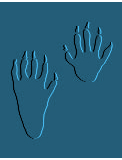(Procyon lotor) RACCOON
How large is Jasper's Raccoon?
- Mass: 3.6 - 9 kg
Length: to 9 in. (23 cm) - Wildlife living area: temperate grassland
Status: Since the turn of the century raccoon populations have grown. As stated earlier, their ability to adapt to urbanization has made them more common in such settings.
Range: Raccoons are found across southern Canada south to northern South America. - The most distiguishable charateristics of the raccoon are its black mask across the eyes and bushy tail with anywhere from four to ten black rings. The forepaws resemble slendor human hands and make the raccoon unusually dextrous. Both their forepaws and hindpaws have five toes. Coloration varies with habitat, but tends to range from grey to reddish brown to buff.
- Raccoons are extremely adaptable and continue to thrive despite the encroachment of civilization on their range. Woodlands near water are their preferred habitat, although raccoons may also be found in farmlands, suburban or urban areas. Raccoons prefer to den in trees, however, they may also use woodchuck burrows, caves, mine shafts, deserted buildings, barns, garages, rain sewers, or houses. Living in a burrow actually increases the raccoon's chances of survival making it harder for its predators to find it. Hunting dogs have an easier time treeing a raccoon than forcing it out of a burrow.
Where do Raccoons Live?
Details on the Jasper Raccoon
Adult raccoons can be savage fighters if cornered. Few dogs can successfully attack an adult who is ripping and slashing with their teeth and claws. Raccoons may even drown their opponent if in water. Raccoons may live up to 16 years in the wild, but most don't make it past their second year. The primary causes of death are humans (hunting, trapping, cars) and malnutriton. Most of the raccoon's other natural predators are no longer found in their range.
The hindprints of a raccoon resemble miniature human footprints. The flat-footed foreprint shows five long fingers and claws which can easily turn doorknobs and open refrigerators. Hind prints are 4 in. (10 cm.) long and claws are clearly visible.

Raccoon Tracks

